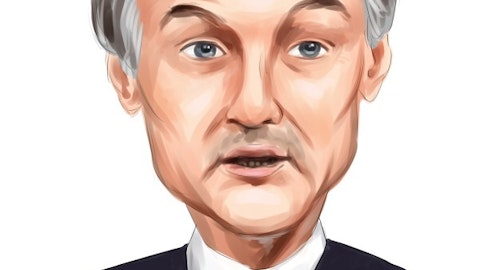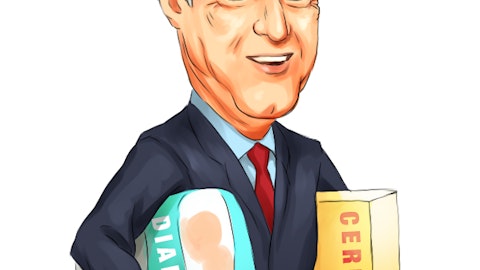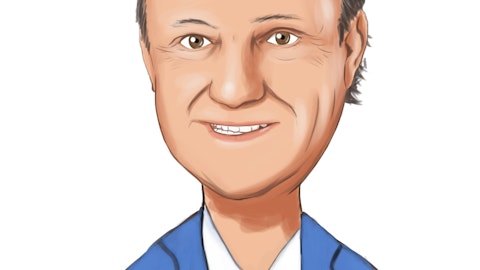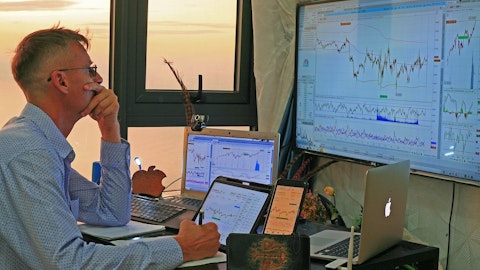Diebold Nixdorf, Incorporated (NYSE:DBD) Q4 2022 Earnings Call Transcript February 9, 2023
Operator: Good morning. My name is Bailey, and I’ll be your conference operator today. At this time, I would like to welcome everybody to the Diebold Nixdorf Fourth Quarter 2022 Conference Call. All lines have been placed on mute to prevent any background noise. After the speakers’ remarks, there’ll be a question-and-answer session . Ms. Marchuska, you may now begin your conference.
Christine Marchuska: Thank you. Hello, everyone. And welcome to our fourth quarter and full year 2022 earnings call. I’m Christine Marchuska, Vice President of Investor Relations for Diebold Nixdorf. To accompany our prepared remarks, we have posted our press release and presentation to the Investor Relations section of our corporate Web site. Later this morning, a replay of this webcast will also be available on the Investor Relations section of our Web site. Before we begin, I will remind all participants that during this call, you will hear forward-looking statements. These statements reflect the expectations and beliefs of our management team at the time of this call, but they are subject to risks and uncertainties that could cause actual results to differ materially from these statements.
Additional information on these factors can be found in the company’s periodic and annual filings with the SEC. Participants should be mindful that subsequent events may render this information to be out of date. We will also be discussing certain non-GAAP financial measures on today’s call. A reconciliation between GAAP and non-GAAP measures can be found in the tables of today’s earnings release. And now, I’ll hand the call over to Octavio.
Octavio Marquez: Thank you, Christine, and thank you all for joining us today. Before I start, as we announced this morning, I want to thank my colleague and friend, Jeff Rutherford, for his leadership over the past four years and his significant contributions to our company. I look forward to working with him over the next few weeks as he transitions his CFO role to Jim Barna, our Head of Treasury and Tax, who has been part of our succession planning for the CFO role, has been instrumental in refinancing our debt and improving our operating model. I am excited about working with Jim during this new chapter for our company. With that, I will turn it over to Jeff for some remarks.
Jeff Rutherford: Thank you, Octavio. Over the last four years, we have accomplished a lot here at Diebold Nixdorf, and I’m confident in the path you are taking the company to success. I would like to thank the investment community for your continued support and I wish Octavio and the company the best.
Octavio Marquez: Thanks, Jeff. We also want to say thanks to Gary Greenfield, who stepped down as Board Chair after five years’ role for his service to the company. We are grateful for the contributions of these leaders and for bringing us to this point in our transformation journey. As communicated earlier this week, we intend to announce a smaller board in our upcoming annual proxy statement. Our refreshed Board and leadership team are excited and unified about our priorities as a company, which include operational execution and now that our refinancing is behind us, a strong focus on deleveraging. With that, let’s now discuss our quarterly results. From key customer wins to important milestones that are improving our operational rigor, the steps we took in 2022 to position our company for a stronger future will be a springboard for our success.
As I reflect on the past 11 months as CEO of Diebold Nixdorf, I couldn’t be prouder of our employees for helping me navigate an ever changing environment and to our customers for the support they provided and their continued trust on DN solutions. Last year, a significant amount of effort and time were spent on improving operations and completing our refinancing transactions. I am happy to say we ended 2022 on a positive note, both with the closing of our Transaction Support Agreement and finishing the year with a record high backlog. Closing the TSA was an important milestone that provides us with the capital we need to normalize our operations, meet supplier commitments and fully execute on our value generating model. It also allows us to put our focus solely back on meeting customer demand.
Converting our record high $1.4 billion backlog into revenue. Banking composes $1.1 billion of the backlog with retail composing the remainder $305 million. We now have scheduling and confirmation of 75% of our ATM unit count and 60% and 35% of our SCO and EPOS unit count respectively for 2023. As we continue to shift our customers and installed base to the new DN Series recycling ATMs and rolled out our self checkout family, including our new retail EASY ONE solution. Closing out 2022 with backlog and financial stability has allowed us to enter 2023 focused on clear priorities for our customers, employees and shareholders. Our focus is straightforward, deleveraging, free cash flow generation and evaluating all strategic opportunities, based on the following three goals.
First and foremost, we plan to deliver our products to our customers and maintain operational excellence. Let me be clear. In the operational plan we presented in our last call, we are committed to delivering 60,000 ATMs, 35,000 SCOs and 134 EPOS in 20 23. Delivering these products is our first and primary focus as it translates directly into revenue and financial stability. Next, we will stabilize and grow our recurring revenue, protecting and selectively growing our contract base. And importantly for the leadership team and I, we will reinvigorate our culture after a year of so much change. These priorities plus starting the deleveraging process are the foundation for our 2023 model, and we are committed to building and delivering our core solutions with a strong focus on unit conversion and unit economics.
We started talking about this last quarter and we believe it is the most simple and effective way to evaluate our performance from an operational standpoint. As I mentioned previously, in 2023, we plan to recognize revenue for 60,000 ATMs, 35,000 self checkout solutions and 134 point of sale devices. We have clear line of sight to our ability to manufacture and deliver these units. Stabilizing our business around our core expertise to drive growth and execute around our contract base will also expand our recurring revenue opportunity, creating longer term value. And finally, we continue to optimize our pricing strategy and we will see the benefit of these actions throughout the year. As the multiple pieces of our global supply chain continue to stabilize, we will see some variability quarter-over-quarter through 2023.
However, with the significant work done in 2022, such as getting our Ohio manufacturing facility fully operational and setting up contract manufacturing for the India market, we are building resiliency in our operations. As we implement our plan, we will be diligent in managing our working capital and liquidity. And make sure that costs don’t creep back into our business as we continue to look for additional efficiencies. Demand for our banking and retail solutions in the market is high and we will deliver. I look forward to sharing more information with you on these company wide priorities in future quarters. Now, I would like to turn it over to Jim to cover our Q4 2022 financial performance.

Jim Barna: Thank you, Octavio. My prepared remarks will include references to certain non-GAAP metrics, such as adjusted EBITDA, Today, I will spend my time discussing the fourth quarter results relative to the full year 2022 operating model, included in our last earnings report on November 8th. For a discussion of our fourth quarter and full year performance relative to prior periods, please see the financial summary included in our earnings release. Total revenue of approximately $969 million was largely in line with our Q4 risk adjusted operating model. We revenue the following units in Q4; 17,000 ATMs, approximately 6,000 SCOs and approximately 33,000 EPOS. Adjusted EBITDA of approximately $104 million was also in line with our Q4 operating model and represents a sequential improvement of approximately $28 million or approximately 37% over the third quarter.
The sequential improvement was driven by higher conversion of units to revenue along with continued execution on our cost savings plan and marks the return of exceeding $100 million of quarterly adjusted EBITDA. For the full year we revenue total revenue for the full year total revenue of approximately $3.461 billion. We recognize revenue on the following units and full year 2022; approximately 49,000 ATMs, approximately ‘21,000 SCOs and approximately 126,000 EPOS. Adjusted EBITDA of approximately $265 million was in line with our model considering the risk previously communicated in Q3. Turning to 2023 for a moment. With respect to liquidity, we are modeling to have adequate liquidity throughout 2023 to run our business and execute on our plan, and we’ll vigilantly manage liquidity through increased operational rigor.
We ended 2022 with approximately $345 million in liquidity and as for our model are targeting to end 2023 with greater than $375 million of liquidity. The increase is modeled to be the result of positive free cash flow generation net of anticipated debt paydowns in Q4 of 2023. Now, Octavia will walk you through our banking and retail business and financial highlights.
Octavio Marquez: We had a strong number of customer wins during the quarter. In banking, the shift from legacy ATM devices continued as our new DN Series cash recyclers comprised approximately 80% of total new banking orders in North America in the fourth quarter. In terms of financial performance, banking revenue came in at $689 million and segment operating profit was $102 million. Both metrics were up sequentially due largely to increased unit delivery and continued focus and driving efficiencies in the business. In retail, we saw contract based growth in self service solutions, including self checkout as the vast majority of SCO shipments represent new placements in the market and have generally a strong service attachment rate.
Coming up — of strong National Retail Federation show better known as NRF in New York City in January, our retail solutions remained in high demand and our self checkout business continues to grow faster than the market, especially as we have started the rollout at a major grocer in the US. Increasingly, more US based retailers are seeing the difference of the DN SCO experience in these stores. In addition, we are also very excited about our new DN Series EASY ONE product, which received great feedback from over 160 customers who attended the launch during the NRF show. We believe this product is the game changer, because it allows retailer to easily and economically move from a traditional checkout to a self checkout to stay ahead of consumer preferences.
Retail revenue was approximately $276 million in the fourth quarter, while segment operating profit was $44 million. Sequentially, revenue growth was largely product driven, which was a function of improved self checkout volumes and a rebound in third party solution business. Operating profit improvement was largely the result of gross margin improvement due to higher volume and mix. Despite significant supply chain challenges, retail managed to grow low single digits, excluding currency and divestitures in fiscal year 2022. Now, I would like to provide you an update on the cost savings plan we implemented last year. We entered 2023 with $175 million of executed run rate cost savings and expect to close the year with a run rate of $190 million.
We continue to target the midpoint of 2023 for completion of the restructuring and expect to see some cost savings benefits in the first half of the year, offset by the reinstatement of our annual incentive compensation and merit pay increases. In closing, as we look ahead in 2023, we are well positioned for success with a strong order pipeline and a straightforward focus, converting our backlog into revenue. I’d like to recognize our incredible employees for their hard work and dedication, especially during a year of considerable change, their hard work, discipline and unwavering commitment to our customers are making a real difference in our efforts to strengthen our business and our competitive position. We look forward to continuing to make important strides to deliver world class products and services that meet the demands of our banking and retail customers, while sustaining our market competitiveness.
We are building momentum and we’ll leverage our leadership position to capitalize on opportunities and transforming — in a transforming industry. I am excited to move forward in 2023 with a clear plan to success and a strong committed global team. With that, I will now turn the call over to the operator for Q&A.
See also 11 Undervalued Mid Cap Stocks To Buy and 12 Cheap Monthly Dividend Stocks To Buy.
Q&A Session
Follow Diebold Nixdorf Inc (NYSE:DBD)
Follow Diebold Nixdorf Inc (NYSE:DBD)
Operator: The first question today comes from the line of Matt Summerville from D.A. Davidson.
Matt Summerville: Couple of questions, maybe first let’s talk about pricing versus input costs. What was your total price capture in 22 and how much incremental price do you intend to capture in 23? And with that, what will your price cost ratio look like?
Jeff Rutherford: So Matt, thanks for the question and one with multiple ways to answer this for you. So let me start with the pricing question. Clearly, as inflationary pressures, you know, accelerated through 2022, we needed to take pricing action. And with extended supply chain lead times, we were always a little bit behind the curve and our cost to price ratio. We made significant changes to improve supply chain velocity, which we will start seeing. And I am confident that we’ve worked through most of the backlogs that was, I would say, incorrectly priced or priced not considering some of the inflationary pressures. So as we stated in our operating plan, you can see the walkthrough and we expect to get to go to our historical margins by the end of the year.
So that’s — I would tell you that’s the work that we’re doing in that aspect. It is important to note we’ve changed many things around pricing. The frequency, the monitoring of input costs that in this changing environment needs to be done almost on a daily basis is one of the changes. We’ve changed sales compensation so that our sales teams are more heavily compensate or compensated based on the profitability of the deal set they bring. So I am very confident — and we can probably walk you through in a different call through all the pricing elements that are at play. But we feel confident that all these actions will help us get back to our historical margins. The other part of your question, Matt, around input costs. We do see that input costs have started to — have stabilized and are actually starting to trend in the positive direction.
I would give you the clearer examples. One of the biggest headwinds that we had was around microelectronic components, both in availability and cost. We see the cost starting to normalize and availability improves — has improved significantly. Another big input cost has been global logistics, where we now see container pricing trending favorably. It started trending favorably at the beginning of the quarter, and we continue to see that trending favorably. So I would say that both the new pricing discipline, the new pricing actions that we’ve taken, plus a step stabilization on the component input, I think it’s still too early to call that it’s a significant reduction. But at least we see that it has stabilized and now starting to trend in the right direction, will clearly be beneficial as we go through the year.
Matt Summerville: And then just as a follow-up, Octavio, now taking on the role as Chairman, I’m wondering if this maybe allows the company to think differently strategically about the business. And as Chairman, CEO, do you think it makes sense for the company to formally look at a strategic process as a means to drive accelerated deleveraging?
Octavio Marquez: So Matt, the first thing I’m very excited about the way the company has structured itself, I think it’s part of a broader plan that the Board of Directors has. We are refreshing our Board, creating a smaller Board. The decision to combine the CEO and Chairman positions is very clear. For the time being, we have to be very, very aligned on the priorities for the company. One of them is deleveraging, that I want to be very clear about. So we will clearly evaluate all options and that is something that we asked, the Board is very conscious about, and we will look at all possibilities. There is operational things that we can do to deleverage. We will use every tool at our disposal to really look at how we change the trajectory of the debt that the company has, the debt burden that the company has. So I would tell you that we will look at all alternatives and this is one of the priorities of our board.
Operator: The next question today comes from the line of Paul Chung from J. P. Morgan.
Paul Chung: So just on ATM shipments, you recognized I think 49 for the year. I think the 3Q guide was around 52. So what drove the shortfall there? And on the confirmed 45k orders for ’23. Is this higher than normal confirmed orders this early in the year given some of the component shortages kind of hitting last year? How confident is the firm on kind of delivering on those units this year? And then I have a follow-up.
Jeff Rutherford: Let me start with the one around where do we stand today with our backlog and confirm manufacturing and deliveries to customer. As you saw, we have north of 70% plus in ATM, 60% in SCOs. These are orders that are now scheduled in our manufacturing, are clear to build based on the customer schedule. And clear to build to us means that, we either have all the components we needed or we have commitment from our suppliers to deliver those components in the time that we need those components to complete those units. So I would tell you that our view is we are extremely confident about delivering on those units. So as far as how does that compare to history, and again, I’m always a little reluctant to talk about history because the world has changed so much over the past year, at least over the past two years.
But if we look historically, we have never started the year with more than 30% of our backlog in this position. So we are clearly in a much better position right now to deliver on our operational plan than we have ever been before. So I’m confident about that. And the other side is we continue to receive significant orders from our clients. Our backlog, even though, our revenue group didn’t reduce as much as we were expecting to be, because we had strong order entry, that, again, that surpassed our expectations. So that helped us continue building on that backlog. So to make a long story short, Paul, we feel very confident on delivering on those units. And we feel very confident that with the demand and rescheduling backlog, we will get to the stated goals that align to our plan.
Paul Chung: And then on the plan revenue unit of 60k, that would suggest 20% increase in units. So how does that 60k unit projection translate to overall banking revenue results for 23, can you talk about the ASP mix, FX that you’re seeing, services attached rate and software?
Octavio Marquez: So Paul, we will start disclosing as we go into Q1, the revenue — the units we manufacture. And remember, we don’t manufacture neither ATM nor a SCO or EPOS device without a firm customer order. So we’ll start disclosing how many devices we manufactured and how many of those turned into revenue during the quarter. Let me give you a hypothetical example of what you will see. In the ideal world, we plan to deliver 60,000 ATMs for cash flow reasons and linearity, it would be great if we could manufacture 15,000 ATMs every quarter and then revenue 15,000 ATMs every quarter. What you will see us doing is probably Q1 and a portion of Q2, our manufacturing will exceed our revenue as we’re shipping ATMs across the globe.
But starting the second half of Q2 and forward, you’ll start seeing our manufacturing be lower than the units that we start revenue. So you’ll start seeing that flow and we will share that with you. As far as the ASPs and that, we will keep it consolidated. Remember, depending on the type of unit, whether it’s a recycler or a cash dispenser, whether it’s being sold to a large national bank in the US or a small credit union or a global bank or Asian customer, the ASPs have rate variations, but we will start giving you more color around that into the future. For now — because in any given quarter, there can be some variation based on geographic mix and product mix. But overall the year it should be a fairly straightforward calculation.
Paul Chung: And lastly, on free cash flow. Have you provided an initial outlook for 23? I didn’t see it. But how do we think about kind of working cap dynamics, cash interest expense, CapEx and your expectations for how cash builds through the year?
Octavio Marquez: So I’ll turn it over to my colleague Jim, so he can answer his first question as incoming CFO, Paul, so he will always have a special place in his heart as the first question comes from you
Jim Barna: Paul, we kind of couched it there in the context of liquidity, right? I mean, we’ve talked about where we ended 22 and then where we expect to end 23. And so you can appreciate that within there is positive free cash flow generation, and the improvement absent all of the one time items that we have in 2022, to your point, is going to come from a fair amount of working capital efficiency. And as it relates to how we see that sequencing throughout the year, to Octavia’s point, I mean, that’s something that we continue to work through as we layer in where those efficiencies kind of mark themselves throughout the year.
Operator: The next question today comes from the line of Kartik Mehta from Northcoast Research.





